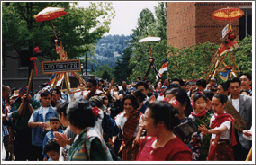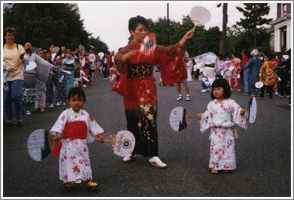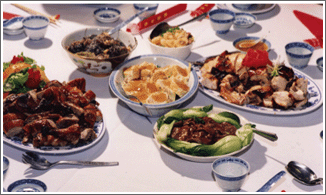Part III: Our Traditions
In this three-part lesson, students will learn about the importance of traditions, including ceremonies and festivals, as an expression of cultural identity. To investigate their meanings of the traditions, students will conduct a cross-cultural survey of ceremonies and festivals celebrated by members of the class, the school, or others in the community. (Recommended chapters: 8, 10, 11, 12)
 |
Our ceremonies and festivals |
1. After students have read selected chapters from the text, have them consider the following questions about ceremonies and festivals:
- •Why do people have ceremonies and festivals? What purposes do they serve?
•If they are religious in nature, how do they emphasize or reinforce shared beliefs?
•If they are more (or strictly) secular in nature, what general community or culture performs them?
•How can they be a form of remembrance or thanksgiving?
•How can they commemorate a specific event or person?
•How can they celebrate personal life events or rites of passage?
•How can they keep past traditions alive? How can they be directed toward future generations?
2. Using the responses generated in the above and information from the selected readings, have the students discuss traditions in the form of specific ceremonies and festivals described in the readings. For each, list the following information:
•The purpose •The main activity or event •Key participants, guests, or positions of honor |
 |
•Special music or dance associated with the festival/ceremony
•Special costume or clothing
•Special food or drink
•Special language or texts
•Offerings or sacrifices
•Other special objects or artifacts
•The calendar or timing
3. Next, have the students generate a list of their own traditions based on the cultural makeup of the class, school, or larger community, and information gathered from the earlier activities. Thinking about their own festivals and ceremonies may be a good starting point, but traditions may include other
kinds of shared activities and behaviors as well. Ask the students to provide information from their own experiences and from their work from previous activities in Parts I and II.
4. Referring to the new list, lead the class in producing a summary report or essay that compares and contrasts their own separate and collective traditions from those included in the text. Begin by brainstorming and recording thoughts that occur to students as they review the list.
Next, help the students group their ideas into categories – for example, “Ways in which our own traditions are similar to those in the readings”; “Ways in which our own traditions are different from those in the readings”; “Traditions we share as group”; “Traditions we celebrate separately” etc. – and begin to construct an outline.
Guide the class in composing a communal essay or report on the role of traditions in their own lives. Help the students generate a thesis statement and topic sentences. Have the students dictate their sentences as you record them on the board or screen.
5. Have the students revise, edit, and proof-read the draft.
Activity 2: Envisioning our traditions
Once the essay is complete, have the students break up into small groups and assign each a single theme or idea from the essay. Have the students think about the kinds of visual images associated with each. As a homework assignment have the students collect images from magazines, newspapers, online sources, etc., that illustrate their own traditions and their separate and collective identities. Allow class time for the groups to create a series of thematically-linked posters or graphics. Display the visuals and the essay text in the classroom, elsewhere in the school, or on a class website.
Activity 3: Performing our traditions
Choose a specific tradition, festival, or ceremony to perform or recreate in class. Make this choice carefully and be sure to observe possible cultural or religious sensitivities. Pay attention to specific calendar events and holidays. Refer back to the list in Activity 1:2 for cues as to how students may participate – for example by bringing in special clothing,
music, food, or other objects. Have students invite relatives or other community members as guest participants who may have special knowledge about and experience with the tradition.

